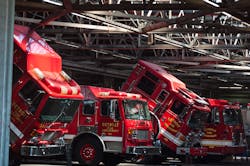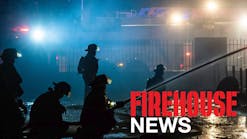Download the full PDF of the supplement here.
A sound vehicle and maintenance replacement program is important to government agencies of all sizes. Be it a volunteer, combination or career department, reliable vehicles and equipment in appropriate working order are essential to providing public services to the communities served in a professional and timely manner. Fire, EMS, wildland, aircraft rescue firefighting (ARFF) and hazmat apparatus and equipment that break down due to age or excessive use will ultimately lead to an interruption in service to the community and a strike against the agency’s dependability and reputation.
While a sound preventative maintenance program is a key component of fleet management, here we’ll dig deeper, addressing how to best evaluate your fleet’s overall performance and the potential need for replacement. You must know your fleet and run it like a business. The more you put into your fleet, the more your “business” responds to cost savings as well as reduced downtime, operating cost and overtime. The goal here is not only to identify what is working, but also to review your department’s current and past practices and make suitable recommendations for improvement going forward.
A complex process
The first step is to develop a viable and comprehensive replacement program or guideline. Without one, managers will be unable to properly assess apparatus and equipment replacement needs in a timely manner. If your agency already has a fleet replacement plan in place or is willing to adopt/create one, the plan needs to be validated. This is an area that has been neglected by many departments and cities for years. Support from upper management is vital to the implementation of the fleet replacement plan. Further, good working equipment contributes to positive employee morale.
In this endeavor, we face many challenges, including still-shrinking revenues, budget cuts in the fleet and support areas, increasing demand for service, increasing state mandates, NFPA 1911 (2012 edition) mandating more annual testing, as well as the age and possible readjustments of the fleet. Readjustments to the fleet throws in a nice twist as the unit(s) that were initially planned for replacement are now kept and reallocated in another division/bureau that “feels” they truly need it. These units now include increased maintenance costs, reduced resale value and increased downtime.
A planned approach
As we begin the process of developing guidelines for a fleet replacement program, we should first start with a simple question: At what age do you like to replace vehicles in your fleet? The fact that a vehicle has reached its replacement age or threshold doesn’t mean it automatically gets replaced. Some wear out faster than others, which may be a sign of the assignment, the intensity of use, and how the end-users take care of the vehicle. Some vehicles may need to be replaced sooner due to extreme wear and tear. As such, a comprehensive replacement program is instrumental in the budget-planning process to determine specifically which units should be replaced. This process sets a guideline as to which units deserve to be replaced and the funding that needs to be available to do so. Additional factors should include two basic categories of fleet expenses: fixed and variable costs.
- Fixed expenses include depreciation, insurance, license plate renewal, annual testing, etc.
- Variable expenses include fuel, maintenance and repair (M&R), accidents, tires, oils, modifications, etc.
Developing vehicle replacement criteria establishes the foundation for a planned approach to fleet replacement and can use one of two primary methods for establishing vehicle replacement cycles:
- The Empirical Method involves using a formal life-cycle cost analysis technique, such as equivalent annual costs, to calculate the least costly life-cycle per class of vehicle.
- The Best Practice Method involves surveying peer organizations with similar fleet and operating conditions.
Regardless of which method is used, life cycles must be developed with the goal to minimize overall fleet cost, maximize vehicle availability, and provide end-users with safe and reliable vehicles to perform their jobs.
Using either method, many agencies have developed a weighted point system that mixes the factors listed above in a formal reporting and review process. The advantage to this is that it removes most of the politics and emotions from the replacement process while providing the facts that all the stakeholders (end-users, management, fleet staff, finance staff, etc.) need in order to understand and buy into the program. A variety of software and various point system programs are used by many fleet agencies across the country. Some are based on overall replacement program using an average while others customize the program to fit different classes or types of equipment.
The chart offers an example of a replacement point system used by Charleston County, SC, for an old pumper.
Applying the chart, I will use a 15-year-old fire pumper planned for replacement in 2–3 years. The unit has 110,000 miles and over 10,000 engine hours, is in poor condition, and includes massive amounts of downtime, poor reliability and repair costs that exceed more than 80 percent of its original purchase price.
The points would be assigned as follows:
- Age = 5 points
- Miles or engine hours = 10 points
- Type of service is severe = 5 points
- Reliability = 5 points
- M&R costs = 3 points (quickly approaching 5)
- Condition = 5 points
Total is 33 points, so it falls into the “Needs Immediate Consideration” category.
As previously mentioned, some systems are based on vehicle types or categories based on the application, preventative maintenance program in place, and the end-user application. In many instances, downtime can be used as an indicator more than how many trips have been made to the shop. Other agencies may use the overall M&R costs average for an entire class or type of vehicle rather than the percentage of the original replacement cost as a key factor.
Another great resource to review the value of age versus points valuation is the Municipality of Mt. Lebanon Proposed Fleet Replacement Schedules 2013–2017, published Oct. 2, 2012.
The next step is developing a fleet replacement policy to define practical conditions and guidelines for the replacement of fleet units. This would be primarily used on fire and EMS vehicles to project the life cycles of those units. The replacement guidelines outlined in this area generally reflect the operational, technological, downtime and financial criteria.
Life-cycle cost analysis
The life cycle of fleet units is based on the Best Practices Method recommended by industry standards. This method involves an internal customer survey using replacement guidelines set forth in the vehicle replacement guide in most fleet software programs. The results are compiled, and adjustments are made in order to take into account factors unique to our fleet, such as utilization and type of use. Once the vehicle has met the replacement criteria, it goes through a review process by the fleet manager/director and the user department to determine if the vehicle should be replaced, retained for limited use, or extend the vehicle’s life cycle. The overall goal is to replace vehicles at the lowest life cycle cost before the operating cost exceeds vehicle capital.
Straight-line method of depreciation
Don’t forget to include depreciation. To comprise the straight-line depreciation method, depreciation is charged uniformly over the life of an asset. We first subtract the residual value of the asset from its cost to obtain the depreciable amount. The depreciable amount is then divided by the useful life of the asset in number of accounting periods to obtain depreciation expense per accounting period. Due to the simplicity of the straight-line method of depreciation, it is the most commonly used depreciation method.
The formula to calculate the straight-line depreciation of any asset for a full financial period is: Depreciation = Cost - Salvage Value/Life in Number of Years.
For example, on Jan. 1, 2017, Fire Department A received a new pumper for $575,000. It is expected to have an approximate value of $10,000 at the end of 15 years of service. First, find the depreciable amount which is $575,000 - $10,000.00 residual value = $565,000. Then divide the depreciable amount by 15, which is the useful service life years of the pumper. This provides a figure of $37,667 for the yearly depreciation.
Replacement class system
The Replacement Classes and Replacement Guidelines are used to categorize the various types of fleet units and their target replacement miles, hours and age in addition to each unit’s operational feasibility while analyzing the most current technology. Some of the consideration for replacement:
- Units that have met replacement criteria
- Units with replacement deferred from prior years
- Units that have reached maximum points or using the Fleet Software Replacement program
- Units that have excessive operating cost
In sum
Regardless of the specific program your agency chooses to practice or create, using a point system is an excellent way to bring credibility and ownership to a process that can be bursting with politics and emotions. Recognize that the most economical method provides the lowest net cost since vehicle replacement funds usually will be in short supply. Having a well thought out and credible plan will not only benefit the fleet operation but also the direction of those future funds.
Brian Brown
Brian Brown, a consultant with Craven and Associates, is the retired bureau chief, fleet services for South Metro Fire Rescue in Colorado, with more than 30 years fire/apparatus experience. Brown is a member of the Firehouse editorial board.






